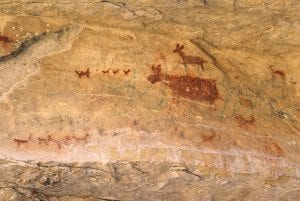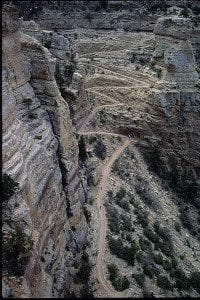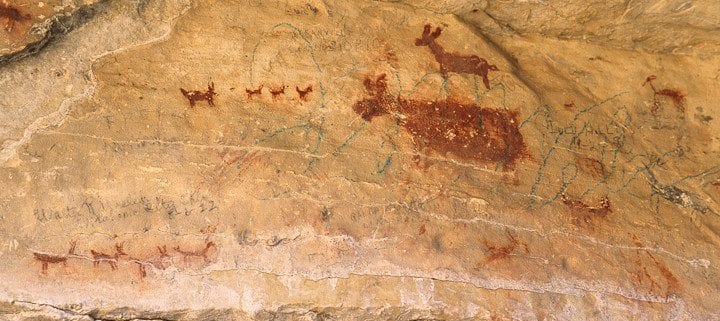Grand Canyon Experts | A Conversation with Gary McCarthy
Q. What is your main perspective on the Grand Canyon and surrounding canyon country?
A. I am absolutely fascinated about the human history of the Grand Canyon. Where did they come from, how long did they stay and where did they go? Some of The People have never left…such as the Hualapai and the Havasupai who still live both beside and deep inside the Grand Canyon and farm in the side canyons.
Q. How do we know that the Grand Canyon has been inhabited off and on for many centuries?
A. They have left their stories in petroglyphs, pictographs and we have found their small

Pictographs, Bright Angel Trail. Photo by Stewart Aitchison
treasures of corn, pottery and the amazing little stick figures shaped like goats.
Q. What makes the early human history of the Grand Canyon so compelling?
A. There are experts who could answer this question better than I can, but as a novelist I focus on what life must have been like deep in the Grand Canyon for these small groups of Ancient Ones. It seems pretty certain that because of the sheer size and difficulty getting in and out of the canyon that there were never any large collections of Native Americans or major ceremonial sites. Nothing like you encounter at Mesa Verde or Chaco Canyon. And yet, is it so difficult to imagine that there might have been the equivalent of shamans and medicine healers that made the difficult descent into the Grand Canyon to minister their special powers?
What I find most intriguing is how the Ancient Ones would have adapted to this awesome landscape one mile deep surrounded by stone. When they looked up at the wedge of sky and felt the power and spirituality of the Grand Canyon would they have been as filled with wonder as we are today? I am sure that they were!
Q. You wrote a series of National Park historical novels, each with very different stories. Grand Canyon Thunder, Mesa Verde Thunder, Yosemite Thunder and Yellowstone Thunder. I would imagine that the research you put into these novels was a very important component to their success. Can you tell us what stands out in the research you did for Grand Canyon Thunder?
A. When I was doing the research for that novel one of the places that I had to see and explore was Paria Canyon and the historically important crossing of Lees Ferry. I recall that it was midsummer when I arrived there and the temperature was approaching 120 degrees. When I stepped out of my air-conditioned truck, the heat struck me like a hammer and I recall thinking how incredibly punishing it must have been for the early Mormon settlers to live there given the punishing heat and isolation. One of the first things I always do when I get to an historical site is to seek out the old cemeteries because from the headstones you can sometimes find some amazing information to use in your novel including names, dates of birth and death and sometimes even the cause of the death. At the Visitor Center, I was directed up the canyon to the little cemetery that was surrounded by a small ornamental iron fence. Some of the old gravestones had fallen over and weather had damaged others so much that their inscriptions were illegible. But there was one set of very unusual gravestones that immediately caught my eye…a family of children who had all died within a short period of each other. Why? How did this heartbreaking tragedy occur to this particular family? If there had been an attack by Indians or if the ferry had overturned the dates of death would all be the same. So what happened to these small children whose lonely graves left no answers? With my mind filled with questions I returned to the Visitor Center and asked about those special little tombstones but the only person in the center had no answers either! So I did what any good researcher would do and that was to buy all the little publications that are always a gold mine for novelist. I would strongly urge anyone who has the chance to visit that quiet little graveyard and pay their respects to memory of the Johnson children.
Q. So did you ever discover the answer to this sad mystery?
A. I did. A wagon had arrived at Lees Ferry to cross into northern Arizona and one of the children of that long-forgotten family had died shortly before their arrival at the crossing. The grieving parents, noting how many children were living in Paria Canyon donated their deceased child’s toys, bedding and clothing…all of these items were infected with diphtheria. So a gift of love had turned into a gift of death and I used that story in Grand Canyon Thunder which I thought gave the reader a real sense of how fragile life was in those early days.
Another sad and tragic story surrounding Lees Ferry was the circumstances that took place in during the infamous Mountain Meadow Massacre and that John Lee really was executed by firing squad for his role in that slaughter of innocents.
Q. I suppose there are many tragic stories that took place in and around the Grand Canyon.
A. Oh yes. But there are also triumphant and uplifting stories about people who came

Upper part of South Kaibab Trail. Photo by Stewart Aitchison
there and left not only alive but inspired and forever changed in wonderous ways. For some reason, it is always the serious stories that I find most interesting. For example, few people today realize that the Hualapai Indians who live around Peach Springs on Old Route 66 were once rounded up and force-marched down near La Paz by the lower Colorado River where hundreds of them died of the heat and fever. But they returned a few at a time and now that is part of their proud history of survival.
Q. In Grand Canyon Thunder, the Havasupai people play an important role. Have you been down into Havasu Canyon and to Supai for your research?
A. I have! What a magnificent side canyon with those blue-green waterfalls. And I learned that the early Havasupai lived on the South Rim during winter where they were hunters and gatherers. However, in the summer, they went down into Havasu Canyon and became farmers. My first impression was that they had everything backward! Wouldn’t they have been better off wintering down in the warmer canyon and summering up on top where it is cooler? But obviously they knew a whole lot better than I what was best for their people and when I studied them for the novel, I finally understood and it all made sense.
Q. You begin the novel with the first Spaniards to see the Grand Canyon but quickly go to the incredible Powell Expedition of 1869 and your main character, William Dunn, actually was a member of that party wasn’t he?
A. Yes. You see, the first National Park Series Novel I wrote was Yosemite Thunder and I had all sorts of interesting historical characters I could use such as John Muir, Grizzly Adams and President Theodore Roosevelt. But with the Grand Canyon historical novel I had Major Powell and not much else. After all, there wasn’t any ranching, mining or timbering to speak of down there so what was I going to write about?
In William Dunn, I found the answer to my conundrum. Dunn was a little-known figure and he was the one that led the Howland Brothers out of the Grand Canyon at Separation Rapids despite Powell’s pleas not to do so. So what happened to those three? Most historians believe they were killed by the Paiutes. But what if on the second or third night on the North Rim the camp was attacked by Paiute and only Dunn was expert enough in the wild to escape? Wouldn’t he have been riddled by guilt because he was the one that the more inexperienced brothers had relied upon to take them safely to the Mormon settlements in Utah? And if he was guilt-ridden, might he have tried to atone for his being the lone survivor by doing great things in and around the Grand Canyon? I think so! Here is short scene that I wrote early in Grand Canyon Thunder:
Dunn’s only weapon was his big hunting knife. He heard Oramel’s shouts of alarm join those of his brother. And then Dunn heard the triumphant voices of the Indians. A shotgun blasted. Dunn’s spine turned to ice as the cries of more Indians filled his ears. Go help your friends! Do something to save them! Don’t just let them die without lifting a hand!
Dunn knew that he had to run for his life if he were to have any chance of survival so he grabbed his pack and dashed headlong to the east because the Indians blocked escape to the west. All he knew was that the Howland brothers were dead and he was alive and that he needed to get as big a headstart as he could before the Indians found his tracks and the manhunt began. [From Grand Canyon published by Kensington Publishing Corp. New York, New York 1996 and re-published as Grand Canyon Thunder in 2011 by Canyon Country Books available through Amazon, Google or as a Kindle download.]
Q. When you finish an historical novel set in the West you must feel that you’ve become an expert on the area and its human history.
A. Not at all! There are people who devote their entire adult lives to the study of very specific areas or historic figures and have a far greater knowledge than I do. What I try to do is to educate myself enough so that the reader learns something of the human history and is at the same time entertained by a good story. And I always let them know what is real and what is not in my books. Really, it’s a wonderful way to make a life and a living!
Gary McCarthy is an award winning novelist and author of Grand Canyon and in its newest release: Grand Canyon Thunder.
Resources and for further reading:
http://canyoncountrybooks.com/
Grand Canyon Thunder, by Gary McCarthy, Canyon Country Books, 2011.
The Exploration of the Colorado River and its Canyons, by J. W. Powell, Dover Publications, New York.




 https://pixabay.com/en/rafting-colorado-river-white-water-2095669/
https://pixabay.com/en/rafting-colorado-river-white-water-2095669/